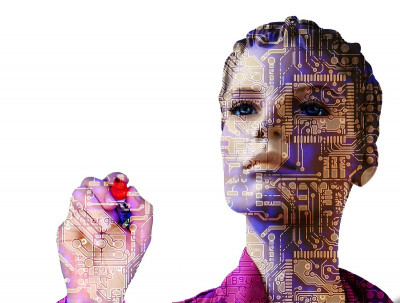Why brands and marketers should embrace synthetic media - Part 1
‘Synthetic media’ is a catch-all term to refer to the content (text, video, and audio) generated by automation. The unfathomable abilities of AI-driven systems, assisted by recent advancements in deep learning, to generate audio/ visual content with such great fidelity is enthralling us in ways that were unthinkable just a few years ago.
In this two-part series, Adgully explores the ways in which marketers can integrate synthetically generated media into disparate use cases such as brand strategy, customer engagement, personalisation, analytics, etc.
Today, a lot of the initial buzz around synthetic media has been driven by the novelty of the technology itself, opines CleverTap Chief Customer Officer Abhishek Gupta.
Going forward, Gupta adds, brands will look for opportunities where they can leverage AI to better forecast trends, understand their customers, streamline communications, and improve the overall experience.
“Not only this, synthetic video and speech technology has already opened up a number of avenues for brands to get creative with their campaigns. Recently a tech giant used a fully synthetically generated video to deliver part of a press conference, and nobody even batted an eye. Such novel applications of the technology lead to enhanced customer perception that can often convert into a rise in tangible metrics. Whether it is fully synthetically generated keynote speeches or AI-driven phone screening features, synthetically generated media is rapidly gaining momentum and will soon cease to be a ‘thing of the future’. These technologies may not fully replace skilled labour, but instead work in tandem to improve productivity and efficiency,” he explains.
As synthetic media steadily progresses, Gupta adds, the integration of AI-enabled systems will support marketers with their brand strategies.
“Customers are increasingly demanding personalised experiences, making it imperative for brands to be able to understand customers and deliver experiences in real-time. Brands will look to integrate such tools natively at the API-level to create a streamlined workflow. We have already seen how WhatsApp businesses are using the power of ChatGPT to provide quicker and personalised customer servicing. As the technology becomes more and more ubiquitous, we are bound to see more innovative and creative use cases of the same,” he adds.
Amazing use cases
Amazing are the way in which automation can create wonders in the marketing domain, points out Rashid Khan, CPO & Co-founder, Yellow.ai. He adds that data analytics and machine learning will enable marketers to gain deep insights into target audience behaviour. According to him, marketing is rapidly evolving into a technology-driven stream of business. As a result, he adds, marketers are actively exploring and adapting the potential of innovative technology across overall strategic planning efforts, enhancing creative competencies, and shaping differentiating customer experience journeys. He refers to a study by McKinsey, which found that AI is expected to have the biggest financial impact on marketing and sales. As such, it can be concluded that incorporating AI into marketing strategies is crucial in order to capitalise on the transformative capabilities of this technology.
“Marketers are, therefore, open to leveraging AI-powered solutions to stay ahead of the curve and enhance the customer experience while gaining the maximum return on their investments. With data analytics and machine learning technology-driven processes, marketers can gain deep insights into target audience behavior. Armed with these insights, marketers are able to craft more impactful customer touchpoints to help better understand audience segments and inform personalized marketing strategies,” says Khan.
According to him, the integration of AI into marketing operations enables a significant enhancement of efficiency and effectiveness. “Automation of routine tasks frees up valuable time for marketers to focus on high-level, strategic initiatives. With the integration of AI into marketing platforms, businesses can generate real-time insights and optimize campaigns in real-time. This also helps businesses measure the impact of these campaigns and marketing activities, enabling marketers to make data-driven decisions and continuously improve their strategies. Additionally, the integration of Dynamic AI agents across voice and chat channels into customer service, support, and commerce strategies has the potential to revolutionize the customer experience through hyper-personalized, 24/7 engagement. This results in a streamlined journey for the customer, ultimately improving the overall customer experience,” explains Khan.
Brand strategy and operations, he explains, will increasingly be shaped and curated with “the voice of the customer” at the heart of it, where setting up a robust feedback process will be critical in delivering successful hyper-personalisation. “Consistent and meaningful engagements with customers across relevant touch points will create more data from which brands will be able to design ever-more relevant experiences – creating a flywheel effect that generates strong, long-term customer lifetime value and loyalty. And AI-powered marketing solutions are enabling all this and more at scale,” he adds.
There’s tremendous potential with AI-powered audio and visual response in customer service, such as interactive voice response (IVR), online reputation management (ORM), and branded media, says Utsav Chaudhuri, Marketing Head – Youth, Music, and English Entertainment, Viacom18. “As the Rights Management evolves with time, a brand can leverage its celebrity ambassadors much more intuitively and richly in personalised communication. Imagine reaching out to the help desk to express your dissatisfaction with the delayed delivery, only to be warmly welcomed by a celebrity’s personal guarantee for a timely response! AI-driven qualitative feedback will propel brands to the next level of engagement with their customers,” he adds.
Generative AI tools, which can create text as well as images, are changing the way marketers work on their brand strategy, notes Mangesh Bhayde, Senior Creative Director - Design, BC Web Wise. Today, he adds, marketers can do a lot more in terms of content creation using AI tools and systems.
Bhayde lists out a few ways in which marketers can seamlessly integrate AI in their brand strategy:
- Content creation: AI can easily generate creative and personalised video, audio, and images that can enhance the quality of marketing campaigns and save time.
- Personalisation: When it comes to personalising advertising messages and recommendations to target specific customers, AI tools can help in creating tailored content.
- Customer engagement: AI-powered chatbots can enhance customer engagement by providing real-time support and personalized recommendations.
- Analytics: When it comes to analyzing customer data, AI tools can help in identifying trends, predicting customer behavior and optimizing marketing campaigns.
- Quality control: By automating repetitive tasks and providing quality control, AI-powered systems can ensure the brand's messages are consistent across all platforms.
- Real-time optimization: With the help of AI tools, marketers can monitor and optimize their campaigns in real-time, based on customer behaviour and engagement metrics.
Brand strategy
AI-generated audio/ visual content can enhance a marketer’s brand strategy by delivering quick, high-quality and personalised content at scale, maintains LimeChat Co-Founder Aniket Bajpai. “Utilise AI-powered content creation tools like chatbots for customer engagement and AI-generated videos for product demos. AI can also be used for targeted audience segmentation and personalisation. Stay updated on AI advancements and align their use with brand values and ethics. Integrating AI-generated audio/visual content can result in more efficient and effective communication with target audiences,” he says.
Priyanka Chugh, Founder & Creative Director, Gypsy Moth, feels feels that AI should be used only to enhance and supplement human originality, not replace it. She suggests that with the optimal utilization of AI, marketers can enhance their strategies via various methods.
“AI can help marketers by generating visual content. Not only does it give a unique look to the result but also elevates it as a whole. We can also see an emergence of hyper-realistic content being created. AI has evolved to curate data with analytics to help gain insights into consumer behaviour and personalize ads for target audiences. Along with functioning as a tool to bolster research, AI is proving itself to be a resourceful device to the audience as a chatbot. Customer service, influencer marketing, and content optimization - all of these are powered by AI. It is advised that marketers continuously monitor and evaluate the effectiveness of AI in their marketing strategies and campaigns. By imposing AI trends, the automation of certain tasks has reached new levels of efficiency that have helped in tailoring personalised campaigns. The holistic integration of AI tools can help marketers unlock higher levels of marketing effectiveness.”
Hyper-personalisation
Hyper-personalised ads using AI and ML that put the consumer at the heart of campaigns will help brands achieve more brand recall, say experts.
Aniket Bajpai also believes that hyper-personalised advertising utilizing AI and ML can improve brand recall by delivering custom messages to each consumer.
“By analyzing consumer behaviour, preferences, and demographics, these ads offer highly relevant content that is more memorable, leading to increased brand recall and a stronger emotional connection between the consumer and brand. Thanks to AI evolution, conversational experiences have improved tremendously in the last few years. Conversational AI has become more advanced, allowing bots to understand and respond to queries in context. These new AI bots, referred to as Level 3 AI, can handle complex and multi-step interactions, allowing the entire purchasing process to take place on a messaging platform. With Level 3 AI, brands can offer hyper-personalised experiences to their customers, from order tracking to product usage support, turning first-time buyers into loyal customers, etc. This level of personalisation has proven to greatly contribute towards stronger brand advocacy,” explains Bajpai.
Rashid Khan says that the one-size-fits-all approach will not work with Indian consumers. “The Indian consumer landscape has undergone a significant transformation, affecting how customers interact with brands, the touchpoints they prefer, and their expectations. A survey by Deloitte showed that Indian consumers have embraced digital channels to shop for essential items, such as groceries and household items, and increased their spending on discretionary items, like apparel and electronics. The market has also become highly competitive, with an abundance of options available for customers due to the growth of e-commerce and direct-to-consumer brands. With the increased reliance on digital commerce and an abundance of choices available online, Indian consumers expect brands to know who they are, what exactly they need, and even interact with them in their preferred language. Over 77% of Indian consumers are more likely to buy again from brands that treat them like an individual, rather than the same as any other customer. They don’t want to be overloaded with messages, mail, or irrelevant communication from brands that are not in alignment with their preferences or needs. It’s no longer about the one-size-fits-all approach, be it with respect to products and services, marketing communications, or customer support. They expect brands to offer highly convenient, intuitive, and instantaneous experiences on their preferred channels and at their preferred times. Brands, therefore, need to re-look at their customer engagement strategies to stand apart from the market clutter. That’s where hyper-personalisation becomes a key pillar to attract and retain customers and enhance their experience,” elaborates Khan.
Mangesh Bhayde feels that while brands have been using hyper-personalised ads to reach their customers for some time, the use of AI and ML to understand consumer preferences and behaviours will definitely help in creating relatable and relevant content that will appeal to the audiences.
According to him, brands can leverage AI and ML tools to create hyper-personalised ads that are specifically tailored to different audiences and create a sense of connection and relevance to the consumer, leading to higher levels of engagement and ultimately increasing brand recall.
Putting customers at the heart of a campaign is no more an option; rather it’s an absolute imperative for the brands, maintains Abhishek Gupta.
Customer expectations are fast evolving and technology is shaping a lot of it, and therefore, brands have to adopt the technology aggressively to match up to those expectations. Brands and marketers are no strangers to leveraging AI/ML tools for hyper-personalisation. Most-modern retention platforms come equipped with these capabilities. However, the dawn of synthetic media significantly lowers the technical bar for most,” says Gupta.
According to him, “creative blocks” may truly be a thing of the past. With advanced AI/ML tools, he points out, creatives and designers can look to such tools to spark ideas, thereby increasing productivity and efficiency.
Hyper-personalisation has proven to be a great way to increase top-of-mind recall. A recent McKinsey research report showed that 71% of consumers expect companies to deliver personalised experiences. Engaging users within the right context, through the right channel at the right place, and the right time, is absolutely essential. Implementing hyper-personalisation, while keeping consumers at the heart of the campaign, not only drives satisfaction, but also increases brand loyalty and creates the elusive top-of-mind recall. It’s not just campaigns, but the overall experience of a user on an app, website or on any other point of touch with the customer, will be an opportunity for brands to deliver hyper-personalised experiences. It’s the experience delivered in these moments of truth that will build or break brands,” he says.
Hyper-personalisation can bring the brand and the consumer closer, says Utsav Chaudhuri. He, however, warns that the woke consumer can also get turned off by such intimate communications due to data privacy concerns. So, the real question for marketers is – are you looking for just brand recall, or positive/ sensitised brand recall?
Meanwhile, Moe’s Art co-founder Vishaal Shah cautions about the risks associated with hyper personalisation. He says, “While hyper-personalised ads using AI and ML can help increase brand recall, it is important to consider the potential risks related to data theft and security. As a large amount of consumer data is collected and used to create these personalised ads, it is crucial that appropriate measures are taken to protect this data and ensure that it is not used for malicious purposes. Brands and marketers should consider working with trusted partners and implementing strong security protocols to protect consumer data and maintain their privacy.”
Rather than being an option, adds Rashid Khan, hyper-personalization has become an imperative. According to him, brands are increasingly leveraging customer data analytics, artificial intelligence, and automation to hyper-personalise engagements with their customers. He cites a recent report by McKinsey, which found that 50% of businesses that are successfully personalising user experiences at scale are using the right set of tools and technology, compared with only 16% of their poorer-performing peers.
“A 360-degree unified platform that enables data gathering, segmentation, and analysis in one location must be at the heart of scalable hyper-personalisation. Yellow.ai’s platform is one such example that enables brands to deliver hyper-personalised campaigns that are curated based on in-depth insights into each customer’s journey. For instance, Yellow.ai Engage, a customer engagement product, enables brands to create a singular view of every customer’s profile by storing user data on aspects including demographics, user preferences, and interests, to name a few. It acts as the personalization engine that brands can leverage to craft hyper-personalised, omni-channel campaigns intuitively. In addition to that, our Analytics solution gives enterprises a detailed understanding of their customers' intent and sentiments with our proprietary NLU engine. They help them track their positive or negative sentimental trends to get deeper insights, including real-time campaign analytics like active status, direct impressions, engagement, audience reactions, and feedback, and leverage these insights to build hyper-personalized campaigns,” he adds.
Furthermore, he adds, in a country like India, where languages and dialects change every 15 to 20 kilometers, consumers expect brands to interact with them in the language of their choice. “By leveraging AI and ML to analyze consumer data, brands can create highly personalised and relevant ads that resonate with their target audience. This level of personalisation can help increase the effectiveness of advertising campaigns and improve the overall customer experience, leading to higher brand recall. This has become another crucial facet of delivering hyper-personalised experiences, where technology is again playing the role of a key enabler.”
“Conversational AI solutions are integrated with multilingual capabilities, powered by highly advanced Natural Language Processing (NLP) engines. Yellow.ai’s Dynamic AI agents have strong multilingual capabilities that enable brands to tailor to an expanded customer base with language localization. For instance, Bharat Petroleum Corporation Limited’s (BPCL) Dynamic AI agent Urja, powered by Yellow.ai, supports 13 languages and is capable of handling diverse queries with the help of our unidentified utterance management module. This has helped to classify and train the AI agent at scale. As more than 45% of the conversations with Urja are in the non-English language-speaking bracket, our solution has ensured inclusiveness for all BPCL customers. Another example is Edelweiss General Insurance, where the Dynamic AI agent for automated motor claim registration can not only interact with garage representatives in Hindi and English but also in Hinglish to cater to their customer base and offer a hyper-personalised experience,” he says.
Marketers can integrate AI-driven systems into their brand strategy by using them to generate audio/ visual content that is engaging, personalised, and relevant to their target audience, says Vishaal Shah. By leveraging the latest advances in deep learning, marketers can create content that is not only aesthetically pleasing but also aligned with their brand's messaging and values, Shah adds.
(Tomorrow, Part 2 of the report will analyse whether synthetic media will do away with traditional linear production/and the arrival of crisis-proof non-human avatars.)











Share
Facebook
YouTube
Tweet
Twitter
LinkedIn